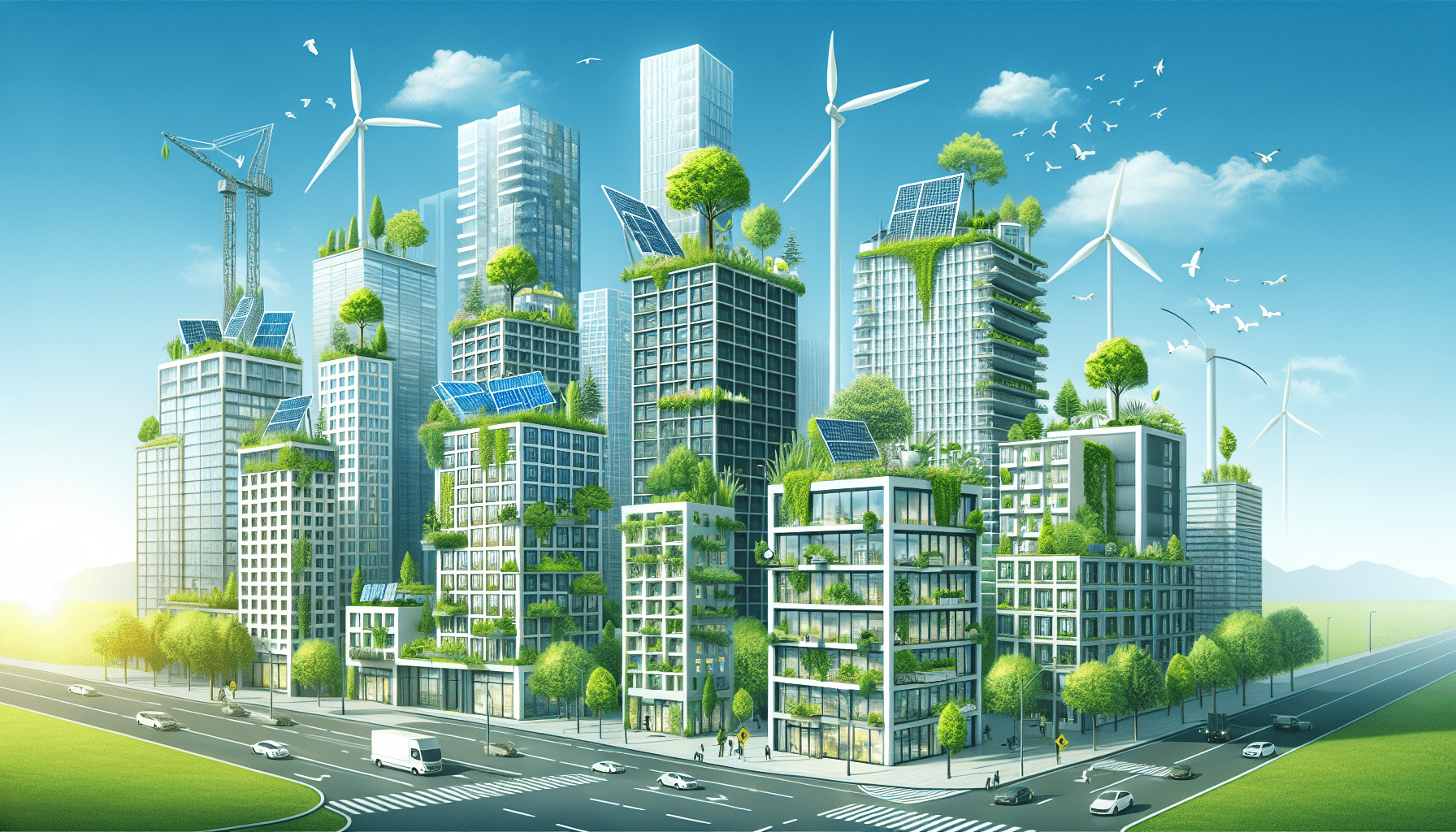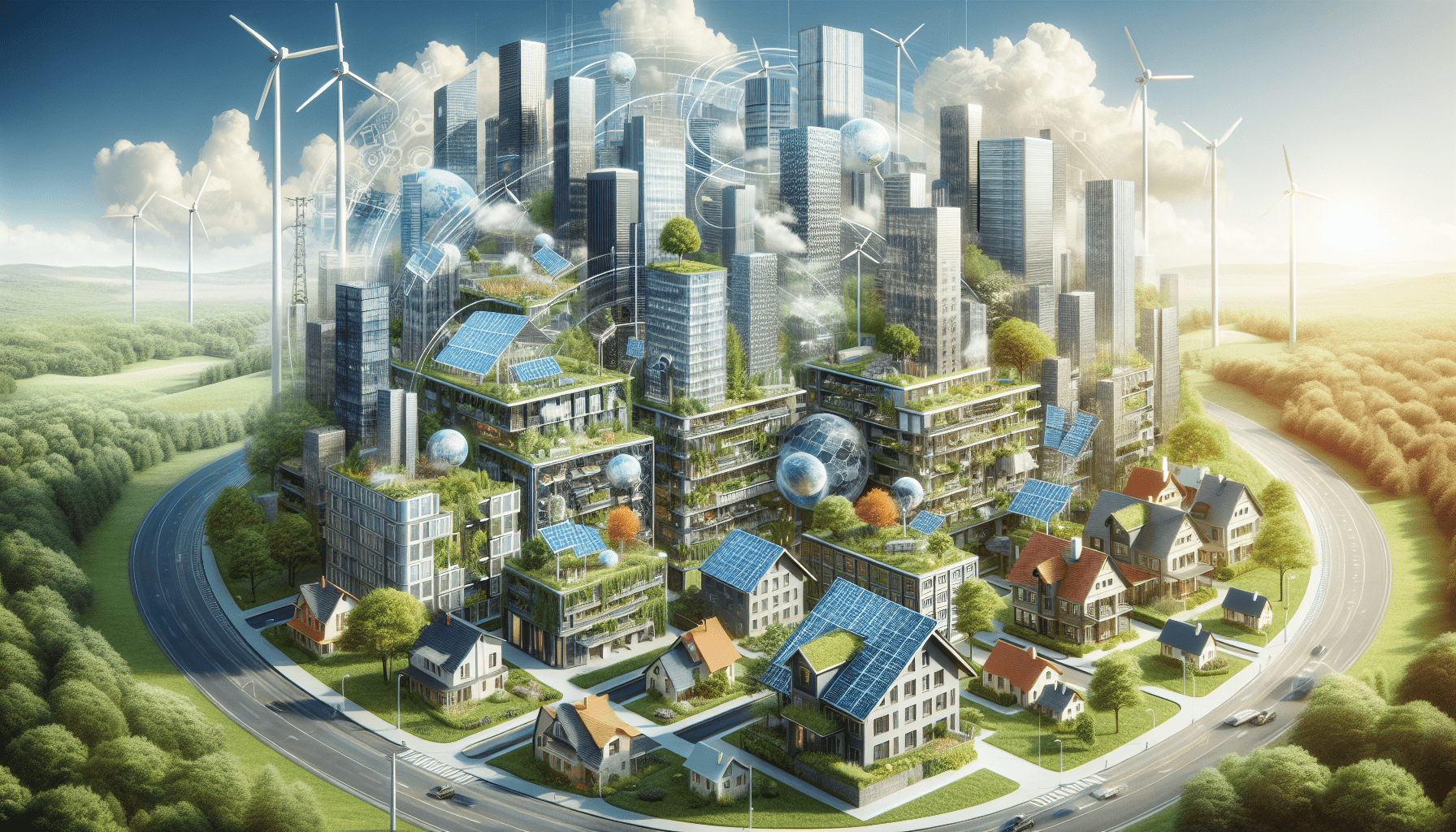Are you interested in investing in real estate while also making a positive impact on the environment? If so, you’ve come to the right place. In this article, you will discover valuable insights on how to invest in real estate with a strong emphasis on environmental sustainability. Whether you are a seasoned investor or just starting out, these tips and strategies will help you navigate the world of real estate with a green conscience. By the end of this article, you’ll be equipped with the knowledge to make informed decisions that align with your sustainability goals.
Understanding Environmental Sustainability in Real Estate
Definition of environmental sustainability in real estate
Environmental sustainability in real estate refers to the development and management of properties in a way that minimizes negative environmental impacts and maximizes positive contributions to the environment. It involves incorporating energy-efficient features, utilizing renewable energy sources, reducing waste, and maintaining the ecological balance of the surrounding areas. The aim is to create buildings and developments that promote long-term sustainability and minimize the carbon footprint.
Benefits of investing in environmentally sustainable real estate
Investing in environmentally sustainable real estate offers numerous benefits. Firstly, it helps protect the environment by reducing greenhouse gas emissions and preserving natural resources. Secondly, sustainable properties tend to have higher resale values and rental incomes due to their energy efficiency and eco-friendly features. Additionally, sustainable buildings attract environmentally conscious tenants and investors, enhancing the overall reputation of the property. Finally, investing in sustainable real estate contributes to a healthier and more enjoyable living environment, benefiting both occupants and the surrounding community.
Current trends and demand for sustainable real estate
In recent years, there has been a significant increase in the demand for sustainable real estate. People are becoming more aware of the environmental impact of their actions and are actively seeking properties that align with their values. This has led to a surge in the development of green buildings, which offer a range of energy-efficient features and environmentally friendly amenities. Many cities and municipalities are also implementing sustainable development plans and regulations, further driving the demand for sustainable real estate. As the trend continues to grow, investing in environmentally sustainable properties is not only socially responsible but also financially rewarding.
Researching Sustainable Real Estate Market
Identifying eco-friendly buildings and developments
When researching the sustainable real estate market, it is essential to identify eco-friendly buildings and developments. Look for properties that have been designed and constructed with energy efficiency and sustainability in mind. These buildings often incorporate features such as solar panels, rainwater harvesting systems, and efficient insulation. Additionally, consider developments that utilize green building materials and integrate natural landscapes to promote biodiversity.
Evaluating energy-efficient features
One of the key aspects of sustainable real estate is energy efficiency. When evaluating potential properties, pay close attention to their energy-efficient features. This includes appliances with high energy ratings, LED lighting, efficient heating and cooling systems, and smart technologies that optimize energy usage. These features not only contribute to a greener environment but also lead to cost savings in the long run by reducing utility bills.
Assessing green certifications and standards
To ensure the authenticity of a sustainable property, it is crucial to assess its green certifications and standards. Look for properties that have been certified by reputable organizations such as LEED (Leadership in Energy and Environmental Design) or Energy Star. These certifications provide an assurance that the property meets specific sustainability criteria and has undergone rigorous evaluation. Investing in certified properties gives confidence in their environmental performance and adds value to the investment.
Identifying Sustainable Investment Strategies
Green building projects
Investing in green building projects is a promising sustainable investment strategy. These projects involve the construction or renovation of buildings to meet high energy and environmental performance standards. Look for opportunities to invest in commercial or residential buildings that prioritize energy efficiency, renewable energy use, and environmentally friendly materials. Green building projects not only offer financial returns but also contribute to reducing carbon emissions and fostering sustainable communities.
Renewable energy investments
Another sustainable investment strategy is to invest in renewable energy infrastructure. This can include solar, wind, or hydroelectric power projects. Renewable energy investments not only offer long-term economic benefits but also help reduce dependence on fossil fuels and mitigate climate change. Consider partnering with renewable energy developers or investing in renewable energy funds to tap into this growing market.
Opportunities in energy-efficient retrofits
Investing in energy-efficient retrofits can be a cost-effective way to improve the sustainability of existing properties. Look for opportunities to upgrade buildings with energy-saving technologies, such as efficient lighting systems, insulation, and HVAC systems. Retrofits can significantly improve a property’s energy performance, reduce operating costs, and attract environmentally conscious tenants. Additionally, governments and utility companies often provide incentives and grants for energy-efficient retrofits, further enhancing the financial feasibility of these investments.
Calculating Financial Returns and Risks
Understanding long-term cost savings
Investing in environmentally sustainable real estate can lead to long-term cost savings. Energy-efficient features and renewable energy sources reduce utility expenses, resulting in lower operating costs over time. Additionally, sustainable properties often attract higher rental incomes and resale values, providing a solid return on investment. Consider the potential savings and returns when evaluating the financial viability of sustainable real estate investments.
Measuring potential property value appreciation
Sustainable properties have the potential for significant appreciation in property value. As environmental sustainability becomes increasingly important, the demand for sustainable real estate continues to rise. This increased demand can result in higher property values over time. Investing in environmentally sustainable real estate positions you well for future appreciation in property value and potential capital gains.
Assessing market risks and fluctuations
Like any investment, sustainable real estate is not without risks. It is important to assess market risks and fluctuations before making an investment decision. Keep an eye on local market conditions, regulatory changes, and economic factors that may affect the demand for sustainable properties. Diversify your investment portfolio and consult with financial advisors or real estate professionals to navigate potential risks effectively.
Building a Reliable Network
Partnering with environmentally conscious real estate agents
When investing in sustainable real estate, it is beneficial to partner with environmentally conscious real estate agents. These agents specialize in sustainable properties and have the expertise to identify suitable investment opportunities. They can provide valuable insights into the local market, connect you with sustainable developers, and help you navigate the process of purchasing environmentally friendly properties.
Connecting with green property developers
Building relationships with green property developers can open doors to exclusive investment opportunities. These developers are experienced in sustainable construction practices and are at the forefront of environmentally friendly design. Engaging with green property developers allows you to gain access to their projects, understand their strategies, and align your investment goals with their sustainable initiatives.
Engaging with local sustainability organizations
Local sustainability organizations are valuable resources for networking and staying informed about sustainable real estate opportunities. These organizations often host events, workshops, and conferences centered around environmental sustainability. Engaging with these organizations allows you to connect with like-minded individuals, learn from industry experts, and potentially discover investment opportunities that align with your environmental values.
Securing Financing for Sustainable Real Estate
Exploring green financing options
Securing financing for sustainable real estate investments can be done through various green financing options. These options include loans specifically designed for sustainable projects, such as green mortgages or energy-efficient asset-based loans. Green financing often offers favorable terms and conditions, such as lower interest rates or longer repayment periods, incentivizing sustainable investments.
Identifying government incentives and grants
Governments at the local, regional, and national levels often provide incentives and grants for sustainable real estate projects. These incentives can include tax credits, rebates, or subsidies for energy-efficient retrofits or renewable energy installations. Identify and leverage these incentives to reduce financial barriers and make your sustainable real estate investment financially feasible.
Partnering with environmentally focused lenders
Partnering with lenders who prioritize sustainable investments can provide additional support and resources. Seek out lenders who have environmentally focused lending programs or partnerships with green organizations. These lenders are more likely to understand the value of sustainable real estate and may offer tailored financing solutions for your investment needs.
Navigating Legal and Regulatory Considerations
Understanding local zoning and building regulations
When investing in sustainable real estate, it is crucial to understand the local zoning and building regulations. These regulations determine what can be built and how it can be built. Familiarize yourself with the zoning codes to ensure your investment aligns with the local sustainability goals and restrictions. Working closely with architects and real estate professionals who are well-versed in local regulations can help navigate any legal hurdles.
Complying with green building codes and certifications
Investing in sustainable real estate often requires compliance with green building codes and certifications. These codes and certifications ensure that properties meet specific sustainability standards and requirements. It is important to understand and adhere to these guidelines to ensure your investment is recognized as environmentally sustainable and achieves the desired certifications.
Managing environmental liabilities and responsibilities
Investing in sustainable real estate comes with environmental liabilities and responsibilities. Identify and manage potential environmental risks associated with the property, such as soil contamination or hazardous materials. Engage with environmental consultants and legal experts to conduct thorough due diligence and develop effective environmental risk management strategies. By proactively addressing environmental liabilities, you can protect your investment and minimize potential legal and financial risks.
Engaging in Due Diligence
Conducting environmental site assessments
Before investing in sustainable real estate, conduct environmental site assessments to identify any potential environmental risks. These assessments evaluate the current and historical land uses, soil quality, and groundwater conditions. They help identify any potential contamination or environmental risks that may impact the property’s value or pose legal liabilities. Environmentally-friendly investors prioritize conducting thorough assessments to ensure the sustainability and long-term viability of their investments.
Reviewing sustainability reports and audits
Reviewing sustainability reports and audits provides valuable insights into the environmental performance of a property. These reports assess the energy efficiency, water usage, waste management, and overall sustainability practices of the property. By reviewing these reports, you can gauge the property’s environmental performance and identify areas for improvement. Investing in properties with positive sustainability ratings and ongoing improvement initiatives offers confidence in their long-term viability.
Analyzing potential environmental risks
Analyze potential environmental risks associated with the property investment. Consider the potential impacts of climate change, natural hazards, and other environmental factors on the property’s value and sustainability. Identify strategies to mitigate these risks, such as investing in properties with resilient design features or in locations with low environmental risk profiles. By thoroughly analyzing environmental risks, you can make informed investment decisions and protect your assets in the long run.
Implementing Sustainable Property Management
Implementing energy-efficient practices
Once you have acquired a sustainable property, implementing energy-efficient practices is vital. This includes optimizing the property’s energy consumption, utilizing programmable thermostats, and installing energy-efficient appliances. Additionally, consider retrofitting the property with sustainable building materials and ensuring proper insulation to minimize energy waste. By implementing energy-efficient practices, you can reduce operating costs, improve tenant satisfaction, and contribute to a greener environment.
Optimizing water usage and waste management
Water usage and waste management are integral aspects of sustainable property management. Implement water-saving measures, such as low-flow fixtures and irrigation systems, to minimize unnecessary water consumption. Incorporate waste management practices that prioritize recycling and composting to minimize the property’s environmental footprint. Adopting these measures not only conserves valuable resources but also enhances the overall sustainability of the property.
Integrating renewable energy sources
Integrating renewable energy sources into your property’s energy infrastructure is a proactive step towards sustainable property management. Consider installing solar panels or wind turbines to generate clean and renewable energy onsite. By utilizing renewable energy sources, you reduce reliance on fossil fuels, decrease greenhouse gas emissions, and contribute to a more sustainable energy future. Explore incentives and tax credits that may be available for adopting renewable energy technologies to maximize the financial benefits.
Monitoring and Reporting Environmental Performance
Tracking energy consumption and emissions
Monitoring energy consumption and emissions is essential for understanding and improving the environmental performance of a sustainable property. Implement energy monitoring systems to track energy usage and identify areas for improvement. Regularly analyze energy consumption data to optimize energy efficiency and identify opportunities for further energy savings. By actively monitoring energy consumption and emissions, you can assess the success of sustainable practices and make informed decisions for ongoing improvements.
Measuring water usage and waste output
Measuring water usage and waste output provides valuable data on the property’s resource management. Implement water metering systems to accurately track water consumption and identify potential inefficiencies. Monitor waste output and track recycling rates to assess the effectiveness of waste management initiatives. Measuring water usage and waste output helps identify areas for improvement and guides decision-making for sustainable property management.
Reporting sustainability achievements and improvements
Reporting sustainability achievements and improvements is an important part of demonstrating your commitment to environmental sustainability. Communicate the property’s green features, energy efficiency initiatives, and any certifications achieved to potential tenants and stakeholders. Regularly update stakeholders on the property’s sustainability performance and highlight any improvements made. Transparent reporting on sustainability achievements not only enhances the property’s reputation but also motivates continuous improvement and sets a positive example for others in the real estate industry.
In conclusion, investing in environmentally sustainable real estate offers a wide range of benefits, from protecting the environment to achieving long-term financial returns. By understanding the definition of environmental sustainability in real estate, researching the market, identifying investment strategies, and navigating legal considerations, you can make informed investment decisions that align with your values. Building a reliable network, securing financing, engaging in due diligence, implementing sustainable property management practices, and monitoring environmental performance are all crucial steps towards a successful investment journey focused on environmental sustainability. With the increasing demand for sustainable real estate, now is the time to invest in a greener and more sustainable future.





